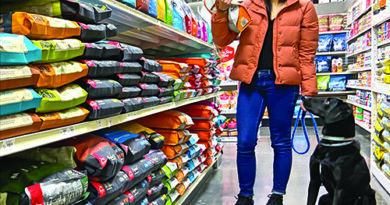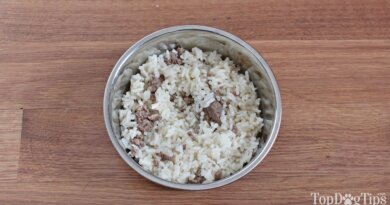Finding The Best Large-Breed Puppy Food
Choosing a food for a new puppy is always a bit worrisome, but for those who adopt large or giant breed pups, selecting the right food is critically important. To prevent rapid growth and ensure proper development, adjustments must be made to the diet formulations for large breed puppy food for puppies who are expected to meet or exceed an adult size of 70 pounds. Here’s what to look for when shopping for the best food for large breed puppies – and how to know when you should stop feeding large breed puppy food.
When looking for a large or giant breed puppy food, it is important to read the statement of nutritional adequacy on the packaging. The standards for the nutritional adequacy of dog foods have been set by the Association of American Feed Control Officials (AAFCO). You will see one of the following statements on foods formulated for growth (which is what most of us call puppy food) or all life stages (which includes the growth stage):
- “[Pet Food Name] is formulated to meet the nutritional levels established by the AAFCO Dog Food Nutrient Profiles for growth/all life stages including growth of large-size dogs (70 lbs. or more as an adult).” This is the statement that must be on the label of any food you buy for your large-breed puppy.
- “[Pet Food Name] is formulated to meet the nutritional levels established by the AAFCO Dog Food Nutrient Profiles for growth/all life stages except for growth of large-size dogs (70 lbs. or more as an adult).” This statement means that the product is not formulated for the needs of large breed puppies. Do not buy products with this statement if you are feeding a large-breed puppy.
How large-breed puppy food is different
Foods that are formulated for smaller puppies can cause large breed puppies to grow too quickly, which can make them prone to skeletal problems. When formulating diets specifically for large breed puppies, several nutritional factors are adjusted to moderate the puppies’ growth rate for a healthier frame.
While all puppies require foods that are higher in energy than foods for the maintenance of adult dogs, the amount of energy fed to large breed puppies needs to be controlled. While large breed puppies grow a lot, they need to grow slowly to prevent developmental orthopedic diseases such as osteochondrosis (a family of disorders that affect bone growth) and acute inflammatory joint disease, which can occur subsequent to osteochondrosis. Feeding a diet that is too calorically dense can lead to your puppy growing faster than their developing bones can accommodate. Because of this, diets for large breed puppies are lower in fat to help control the energy density.
The minerals required for proper skeletal development, mainly calcium and phosphorus, also need to be controlled. While calcium is needed for strong bones, excess calcium can be harmful. Unlike adult dogs, puppies cannot control the amount of calcium they absorb. This can lead to a surplus of the mineral, resulting in skeletal malformations. Diets formulated for large and giant breed puppies have a maximum of 1.8% calcium by dry matter (DM) – significantly less than the maximum of 2.5% calcium (DM) allowed for smaller breed dogs.
Because of the way that calcium interacts with other minerals, a dietary excess of calcium can cause deficiencies in nutrients like phosphorus. Because of the way their levels in a diet affect each other, a proper ratio of calcium and phosphorus is vital for the development of healthy bones. For large and giant breed puppies, the ideal calcium to phosphorus ratio should be between 1.1:1 and 1.4:1. Large breed puppies being fed a complete and balanced diet should not be given any supplemental calcium.
Note:
While AAFCO defines “large breed puppies” as those who are expected to meet or exceed a healthy adult weight of 70 pounds, many nutritionists recommend using 50 pounds as the cut-off for large breed dogs.
When to stop feeding large-breed puppy food
As a general guideline, you can begin to transition from large breed puppy food to adult dog food when your puppy has reached about 80% to 90% of their adult size. This typically corresponds to your puppy reaching his full height, with continued muscle and weight development as he continues to mature. Since large breed dogs grow at a slower rate compared to smaller breeds, their skeletal development typically takes between 12 and 24 months to complete. Consult your veterinarian to assess your dog’s growth to determine the best time to transition to adult food.





